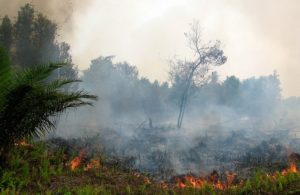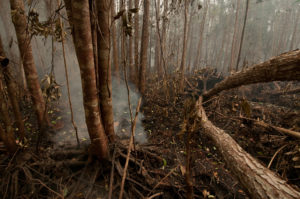
Analyzing 20 years of peat fire management intervention in Indonesia
Indonesia – Almost two decades after the devastating Indonesian wildfires of 1997-1998 drew international attention and prompted a wave of management attempts, extensive fires returned in 2013, 2014, and most severely in 2015, producing a humanitarian and ecological crisis. Since 1998, wildfires have become increasingly decoupled from climate anomaly years, instead occurring on an almost yearly basis.
The destructiveness of the 2015 event has created a renewed burst of political will and governance experimentation around fire management and sustainable management of Indonesian peatlands. It is an opportune moment to take stock of what has been done, and how we can learn from past Fire Management Intervention (FMI) efforts.
The scientific community has been commenting on FMI for some time now. A common thread that has emerged in regard to Indonesian FMI is a critique of the bluntness of the policy instruments- mainly that FMI fail to target their resources strategically (i.e. towards the situations and actors most associated with haze and escaped fire), thus compromising their efficiency, equity, and effectiveness.
This body of scientific work also offers a clear account of the many proximate variables relevant to predicting haze and escaped fire in Indonesia. These include soil type, burn month, and landholder type. We should be asking ourselves whether these variables are being accounted for in FMI targeting, and if so, by who. Are there other methods by which FMI have been specifying targets?

An ongoing study conducted by the Center for International Forestry Research (CIFOR), led by researchers Una Jefferson, Rachel Carmenta, and Jacob Phelps, aims to identify the tendencies between the sector (NGO, business, government, or mixed) mandating FMI, and the methods used to specify the target of intervention resources. In this case, “resources” can mean anything from enforcement capacity to project funds.
The CIFOR study analyzes the suite of FMI addressing peat fires in Riau Province, a center of peat fire activity in Indonesia. The dataset includes FMI between January of 1999 and December of 2016, and was verified through policy document analysis, literature review (both grey and scientific), and consultations with key stakeholders.
It allows the formal content of interventions and the sector and scale of the institutions behind them to be examined, shedding light on the dynamics at play in Indonesia’s diverse environmental governance arena. Although the research is still ongoing, initial analysis of the dataset indicates some early results.
FMI FOCUS ON PREVENTION AND SMALLHOLDERS
What do we know about the focus of FMI? First, the data shows that since 1998, FMI have maintained a de jure emphasis on fire prevention, rather than short-term suppression. This long-standing focus (at least on paper) on addressing underlying causes of the ignition and spread of fires contradicts commentary suggesting that a shift in priorities towards preventative measures is recent. Instead, perhaps the “contemporary” prevention shift consists of a burst of political commitment towards bringing these FMI off the paper and into de facto reality.
Most FMI focus their efforts on landholders, and the bulk of these focus on smallholders rather than on businesses. Around a quarter of FMI target landholders, but they don’t distinguish between landholder types. This is an unfortunate omission, as a nuanced specification of actor type is important in addressing peat fires.
MORE SPECIFICITY NEEDED TO MAXIMIZE FMI PERFORMANCE
Preliminary results suggest the suite of variables linked to causes of haze and escaped fire are not being accounted for in targeting FMI. Soil type (peat or mineral) has important implications for fire incidence and fire escape, not to mention fire-related problems from haze to carbon emissions, and indeed it was the most commonly used of the targeting variables in our set.
Yet soil type was only specified by around half of FMI, and only one quarter were specifically tailored to peatland contexts.
Far fewer interventions target regulatory or project resources to high-risk fire periods (i.e. defined by weather parameters, month, or a set threshold of fire severity). Fewer still distinguish between more than two functional categories of landholder statuses — “smallholder” and “business” — in targeting, despite evidence that this dichotomy masks differences that are critical for the crafting of peat fire policy.
Overall, these results suggest that a crucial element of policy potential is not being harnessed, as policies need to be targeted to specific contexts to maximize their performance.
DIRECT TARGETING: A NON-GOVERNMENT TOOL WITH PUBLIC POLICY POTENTIAL?
Proximate variables are not the only way to specify targets for FMI. Non-government FMI often use fire and haze occurrence itself as a basis for the selection of targets for intervention resources more frequently than government initiatives.
For example, of business- and NGO-driven FMI that employ sanctions and rewards, for the majority disbursement is conditional on performance, while government initiatives emphasize adherence to prescribed codes of conduct that are often broadly applied in areas where the evidence base suggests nuance is needed.
Similarly, the majority of business-driven interventions explicitly employ fire history in site selection for FMI, while until recently (i.e. Peatland Restoration Agency), government FMI tended not to do so.
While the use of proximate targeting variables is similar across sectors, more direct methods are employed by non-government initiatives. This divergence in tools suggests potential for cross-sector policy learning.
RESEARCH CONTINUES
CIFOR’s research will continue through end 2017. Further analysis will include an elaborated, systematic and comprehensive categorization of the scalar and sectorial characteristics of the institutional framework behind FMI and their policy targeting performance.
This will hopefully enable reflection on the specific competencies of the diverse groups determining environmental governance in Indonesia, indicate potential for policy learning, and point to gaps between the content of FMI and the base of scientific evidence that could be addressed in the future.
By Una Jefferson and Rachel Carmenta, originally published at CIFOR’s Forests News.
For more information on this topic, please contact Rachel Carmenta at r.carmenta@cgiar.org.
This research was supported by DFID-KNOWFOR.











